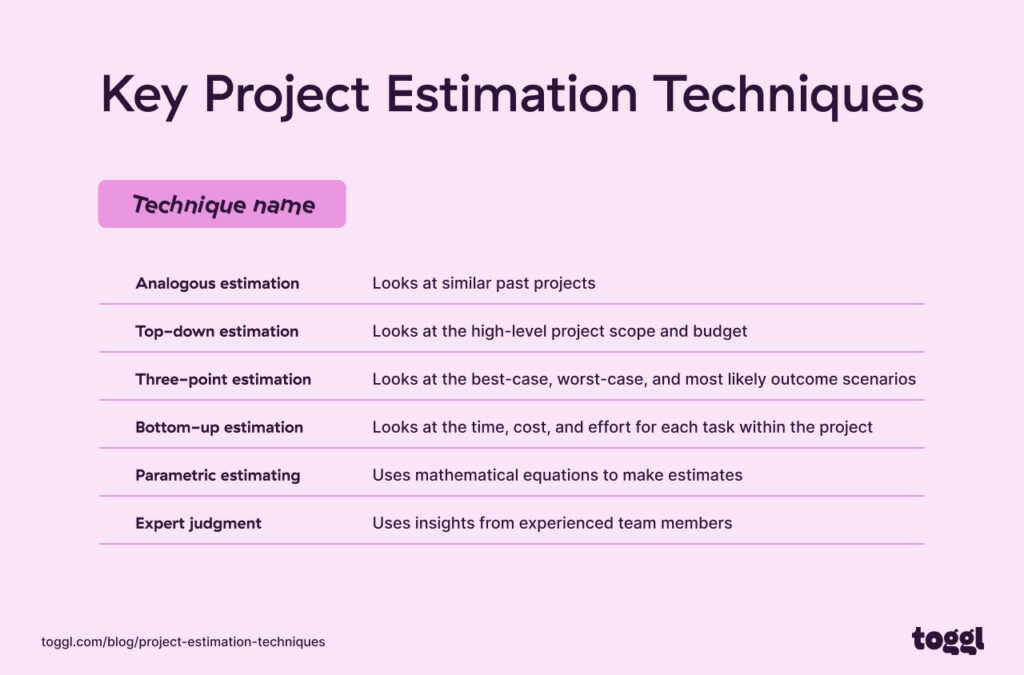The six key project-estimating techniques almost every project manager uses are:
- Top-down estimating
- Bottom-up estimating
- Analogous estimating
- Three-point estimating
- Parametric estimating
- Expert judgment
But how to choose the right one for your project?
You’ll find out in this article.
What are project estimation techniques?
Project estimation techniques are methods used to estimate the time, effort, cost, and resources needed to complete a project.
They help create realistic plans and budgets so projects can be completed on time and within scope.
Although some project estimation techniques are more accurate than others, all of them can help you plan your project.
What types of estimations are there?
Below are the six different types of estimations to consider for a project:
| Cost estimations | Cost estimation involves calculating the total expected costs of the project. |
| Time estimations | Time estimation maps out the schedule and timeline for project tasks, milestones, and deliverables. |
| Scope estimations | Determining the amount of work and number of deliverables needed to bring the project from start to finish. |
| Resource estimations | Determining labor, equipment, and any other resources needed to execute the project. |
| Risk estimations | Evaluating potential issues that may derail the project. |
| Quality estimation | Setting standards for deliverables, processes, and outputs. |
Cost estimations
Estimating the cost of a project is one of the first (and most important) steps in project estimation.
Costs include both direct (labor, software etc) as well as indirect costs (overhead, admin).
The type of cost estimate you create depends on which stage in the intake process you’re at with the client.
Consider creating the following cost estimates for your next client project:
- Ballpark estimate
- Budget estimate
- Statement of work estimate
Each estimate gets more precise as more details emerge. It’s important to start estimating early and refine over time. Upfront budgeting prevents cost overruns down the road.
Time estimations
Accurately estimating the project timeline is crucial for setting realistic expectations and keeping projects profitable.
Creating reliable time estimates requires breaking the project into manageable tasks and estimating the duration of each.
This can be best done by creating a Work Breakdown Structure (WBS) and adding time estimates for each task.

Or you can use historical project data to grab quick time estimates.
The Summary Report inside of Toggl Track allows you to filter your project time entries by:
- Client
- Project
- Tasks
Perfect for getting an overview of how much time was spent on past projects and their tasks.
Learning how to estimate time for a project is an excellent skill and will be the ace up your sleeve for every one of your future projects.
Scope estimations
The scope of a project is the last of the big three estimations.
Scope estimations help you predict all the work necessary to complete the project.
It’s best to scope out a project during a project discovery. This helps you gather all project requirements to create a more accurate project timeline and better manage the budget.
Scope is a project constraint that can quickly spiderweb out and affect everything around it.
Some people think of these first three points (cost, time, scope) as the “project management triangle” because if one side changes, the others do too.

The triangle on the left is a perfectly balanced project.
The one on the right?
Its scope got out of hand, so the project timeline got pushed back, and the project profits took a hit.
Taking the time to estimate these three big constraints will ensure your triangle stays nice and even.
Resource estimations
Project resources can include labor, equipment, software, and materials needed to execute the work.
Your team is likely juggling multiple tasks and projects at the same time. So accurately estimating resources ensures their availability and time are respected.
Resource estimation is the difference between team members so burnt out that they’re asleep at their desks and team members with nothing to do.
Risk estimations
Proactively identifying and planning for project risks is essential to minimize surprises. Risk refers to potential issues that may negatively impact the project budget, timeline, or scope if they occur.
Start by brainstorming risks across categories like budget, schedule, technology, resources, vendors, etc. Review risks from past projects for ideas.
Software development in the cloud? Assume that there could be a server crash.
Factor in risks from the planning stage — don’t wait for them to show their ugly face when the client mentions them first. Or worse, when they suddenly strike.
Quality estimations
Defining quality expectations is crucial so projects meet stakeholder needs and avoid unnecessary rework.
Start by identifying applicable quality standards, requirements, and success criteria based on client needs, industry benchmarks, and best practices.
Estimate the effort required to meet quality specifications. Factor in needs like staff training, testing, inspections, and process controls.
The purpose of quality estimations is to figure out project standards and requirements and how to achieve them.
When you estimate clear quality goals, you make it easier to avoid mistakes and rework. This saves time and money.
Project estimation techniques
There are a wealth of proven project estimation techniques, but here are the ones we think will be most helpful to you:
- Analogous estimation
- Top-down estimation
- Bottom-up estimation
- Parametric estimating
- Three-point estimation
- Expert judgment

1. Analogous estimation
Analogous estimating is a simple way to gain an estimate of the cost of something.
You look at similar projects you’ve completed before and use them as a reference for your estimations.
The issue with analogous estimates is that they tend to be slightly inaccurate.
They assume that:
- You have (accurate) historical data to reference
- There are no differences between projects
Analogous estimating works best when you can compare with similar past projects, and you need a quick and general idea of the project’s time and cost.
It’s most useful in the early stages of project planning, especially when you don’t have detailed project information.
If you’re using Toggl Track, you can easily access the data of past projects within the Project Dashboard.

This will show you what time and costs went into each project.
2. Top-down estimation
Top-down estimating looks at the high-level project scope and budget.
It avoids digging into the nitty-gritty of the work and only helps create a ballpark estimate.
The client’s budget and timeline should be the source for the initial estimations.
It is your job to take their numbers and divide them up so that you know how much money to spend on each task or phase of the project and how long it will take.
This is a form of analogous estimating. Existing knowledge of similar projects is used in the estimation process to produce a ballpark figure for the total cost.
But it’s a solid estimation technique if you have access to similar data from previous projects.
The pros of the top-down method:
- Fast and cheap
- Requires little initial effort
- Pretty accurate if historical data is available
Cons include:
- Low accuracy if no historical data is present
- Can be easy to miss critical components and complexities with a top-down approach.
Top Tip: 100% accuracy is not worth your time at the initial stages of client contact. Giving them a ballpark estimate is the best approach — unless you know they’re serious about working with you.
Completing a project for the first time? You will have to rely on your knowledge and experience of similar work.
You can use historical averages once you’ve completed enough of a particular type of project.
3. Bottom-up estimation
Bottom-up estimating is the most accurate project estimation technique.
Bottom-up estimating considers the time, cost, and effort for each task within the project. It then adds it up to create an estimate for the entire project.
This means it can be a super-accurate estimation technique. You need to have completed a thorough Work Breakdown Structure (WBS) for the project and have access to historical data.
How does a WBS work?
It helps you break down a project into its tasks, which are then estimated separately and added to calculate the total project cost.

Here’s our free WBS template that you can use and customize to create better estimates.
Once you’ve filled out a WBS, you can use Toggl Track to triple-check your estimations.
Pros of bottom-up estimating:
- Calculating from a micro-level boosts accuracy enormously
- Reduces risk due to taking in the small details
- Flexible for a variety of tasks (different tasks take different amounts of time and resources)
What are the cons of bottom-up estimating?
Calculating can be time-consuming and slow-moving without the right tools.
But with Toggl Track, you can easily visualize a breakdown of different tasks within a project.

That way, you can get clear and insightful data about the time and cost of your individual tasks.
4. Parametric estimating
Parametric estimating uses mathematical equations to make estimates.
It relies on specific data, such as past costs or time needed for similar tasks.
The pros of parametric estimating are:
- Accuracy: If you have reliable data, this method can be very accurate.
- Efficiency: Once the model is set up, it can be a quick way to estimate.
The cons of parametric estimating are:
- Data dependence: With parametric estimating, you need detailed, relevant data from past projects. Or the estimates may be off.
- Complexity: It’s quite complicated to set up equations and models. It may need expertise.
Parametric estimating is best for repeated, similar tasks where past data can guide the estimates.
As shown above, you can easily access historical project data in Toggl Track to make your estimates more accurate.
5. Three-point estimation
Three-point estimation combines the best-case, worst-case, and most likely outcome scenarios. This creates an accurate, flexible estimate.
This technique is useful when the client asks for a more detailed cost estimate.
Pros of the three-point technique include the following:
- High accuracy
- A hearty dose of realism
The main con to three-point estimating is the effort required to do it. It’s a pretty labor-intensive process when done properly.
So when is it best to use it?
The best time is when you’ve completed one (or preferably more) projects using time tracking software. That way, you have a wealth of data to measure your new project against, so you’re not starting from scratch every time.
There are two main ways to calculate it:
- Triangular distribution
- Beta distribution
The first treats every scenario equally likely, and the second puts more weight on the most likely scenario.
Triangular is best if you’re working with less data and want a quick calculation.
Beta is the best overall and the most accurate as long as you have enough data to figure out the most likely outcome of your project.
When you view the graphs, the triangular calculation is typically triangle-shaped (who would’ve guessed?) and the beta is more bell-shaped.

To work out the triangular calculation, you need the optimistic, pessimistic, and most likely outcomes. Combine them, and divide them by three.
Let’s say you estimate a project to take:
- 150 hours (optimistic)
- 250 hours (pessimistic)
- 165 hours (most likely)
Your triangular project estimate will be 188.33 hours.
Beta is more difficult, typically adding four times the weight to the more likely outcome versus the best and worst.
So using the data from the example above, you would end up with an estimate of 176.67 hours.
Check out this Three-Point Estimation Calculator if you want to play around with the numbers.
However, that calculator is useless if you don’t know what numbers to plug in.
Use Toggl Track to view past project data on the Project Dashboard to get a quick overview of how long similar projects have taken.
- Optimistic outcome – look at the length of time for projects that went exactly to plan
- Pessimistic outcome – look at the length of time for projects that didn’t go to plan.
- Most likely outcome – look at the length of time for projects that mainly went to plan

6. Expert judgment
Tapping into your team’s expertise can provide valuable insights for estimating project timelines, costs, and resources. Team members who have worked on similar past projects bring crucial experience.
Have team members draw on their knowledge to independently estimate project components they’ll be working on. Compare estimates and discuss assumptions and variances.
Guidelines for team judgment estimating:
- Let team members estimate work they’ll be directly involved in
- Have them document assumptions to justify estimates
- Compile team perspectives to balance biases and blind spots
- Combine with data from past projects for increased accuracy
- Capture lessons learned and data over time so less judgment is required
Why are project estimates important?
Project estimates are important because they help you figure out how much time, money, and people you need for a project.
Without them, you’d be guessing and might run out of what you need.
Estimates make sure you’re prepared and keep the project on track. They’re a roadmap that helps everyone know what to do and when so things go smoothly.
Who estimates projects?
Generally, it’s the project lead who is responsible for estimating the different aspects of each project.
But it is up to the whole project team and any experts to help create and refine the project estimates.
The more people that know about it, the more realistic the estimations will be.
But this will depend on what type of estimation you’re doing and on the size of your business.
Is it a quick ballpark estimate? That’s the responsibility of the project manager. Working on a budget or statement of work estimate? Get the team involved.
We recommend checking out our project cost estimation guide to learn more.
When should estimates take place?
The project estimation process depends on your project intake process. And how detailed you get with your initial project estimate.
You should avoid creating detailed estimates (bottom-up) during the initial stages of the project. This is particularly true if you haven’t gathered all the project requirements.
Define the overall project budget and create different types of estimates before you sign off on a statement of work.
These include:
- Ballpark estimate
- Budget estimate
- Statement of work estimate
Again, it’s worth checking out our project cost estimation guide to learn more about the different types of estimates you can create.
It’s also worth pointing out that your estimation process will depend on your project management approach.
For example, Agile projects take a flexible approach to planning. Most Agile frameworks divide projects into smaller tasks or iterations.
In this case, estimates would be done at the beginning and then again during each phase/sprint.
Now over to you
By looking closely at the most common project estimation techniques, you now know which one to choose when.
This way, you’ll create more accurate estimates for each project you have.
But if you want to maximize your estimating accuracy, a tool like Toggl Track is what you need. Sign up for a free Toggl Track account to create more accurate estimates much easier.
Work tools to elevate your productivity – apps for incredibly simple time tracking and effective project planning.

![What is Project Resource Management? [Comprehensive Guide]](images/project-resource-management-112x67.jpg)



